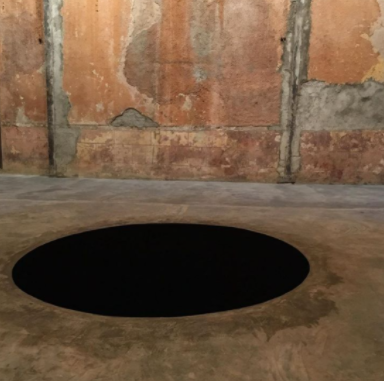In the year 2014, aerospace engineers working for Surrey Nanosystems created a brand new material called Vantablack. The name itself refers to the fact that it is created from vertically aligned nanotubes and is an extremely dark black color. It is so dark that it absorbs almost 99.97% of all visible light and is much different to look at than simply staring at a black screen when a monitor is turned off. The unique properties of this material create many new opportunities for people to harness its light absorption and color. But Anish Kapoor had a different idea.
Kapoor is a British Indian sculptor who made a name for himself by creating works which explored unnerving themes like blood, nothingness, and void. His works are unique since they place heavy emphasis on using specific textures and colors in order to add an additional layer of unsettlement. Of course, due to the nature of Vantablack, Kapoor was extremely intrigued and had to find some way to adapt this new material to his artwork. He made the material more practically usable in the form of a sprayable paint which he named the “blackest black.” This seemed like a great development for the art community at first, as there were countless ideas which could be explored using this new unique color. However, Anish Kapoor immediately bought the rights to the blackest black and forbade anyone from using the color except for himself.
Artists were outraged about Kapoor’s actions, and took to social media to call him out on his actions. Fans of Kapoor were turned away from him as a result of this decision, and some personal feuds erupted as well. Artists Christian Furr and Stuart Semple decided to give Anish Kapoor a taste of his own medicine by creating their own colors. Some examples are the “pinkest pink,” which mocked the name scheme of Kapoor’s blackest black; “black 2.0” and “black 3.0,” both of which held very similar properties to vantablack; and “diamond dust,” which was an extremely reflective color and had a seemingly opposite effect to the blackest black. The catch with these colors, is that Furr and Stuart allowed everyone EXCEPT for Kapoor to use them.
Despite the fact that, to this day, Kapoor has not given up his rights to the blackest black, the art community was still able to find ways around the exclusivity. It raises the question of how far copyright laws should extend? To create a work with the blackest black and copyright the work is one thing, but to prevent anyone from using the color at all seems like an arrogant decision. It is essentially saying that the only one who can properly use the color is Kapoor. Critics were also upset with the fact that not only had Kapoor prevented anyone from using the color, but he had not even created anything spectacular with it at the time. The only work that Anish Kapoor created with the blackest black at the time of this controversy was a black hole on the ground, something that had already been done with vantablack by Surrey Nanosystems.
Since this controversy, MIT has also discovered a new material which absorbs 10 times more light than vantablack. Luckily for the rest of the art community, developments will continue to progress forward, and when one door closes, another is sure to open later on.
https://www.archpaper.com/2017/07/anish-kapoor-blackest-black/


